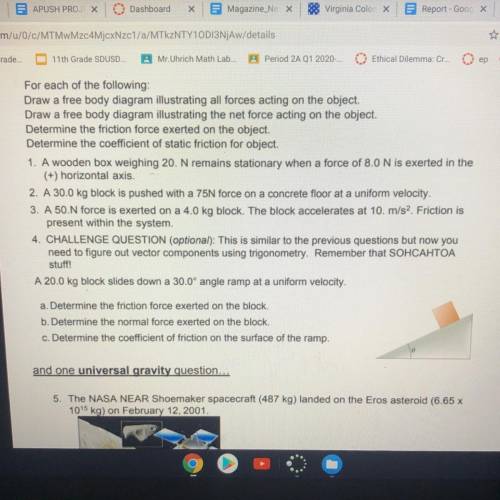
Physics, 18.10.2020 07:01 jasmineharris121
For each of the following:
Draw a free body diagram illustrating all forces acting on the object.
Draw a free body diagram illustrating the net force acting on the object.
Determine the friction force exerted on the object.
Determine the coefficient of static friction for object.
1. A wooden box weighing 20. N remains stationary when a force of 8.0 N is exerted in the
(+) horizontal axis.
2. A 30.0 kg block is pushed with a 75N force on a concrete floor at a uniform velocity.
3. A 50.N force is exerted on a 4.0 kg block. The block accelerates at 10. m/s2. Friction is
present within the system.
4. CHALLENGE QUESTION (optional): This is similar to the previous questions but now you
need to figure out vector components using trigonometry. Remember that SOHCAHTOA
stuff!
A 20.0 kg block slides down a 30.0° angle ramp at a uniform velocity.
a. Determine the friction force exerted on the block.
b. Determine the normal force exerted on the block.
c. Determine the coefficient of friction on the surface of the ramp.


Answers: 1
Another question on Physics

Physics, 21.06.2019 18:10
After the near spacecraft passed mathilde, on several occasions rocket propellant was expelled to adjust the spacecraft's momentum in order to follow a path that would approach the asteroid eros, the final destination for the mission. after getting close to eros, further small adjustments made the momentum just right to give a circular orbit of radius 45 km (45 × 10^3 m) around the asteroid. so much propellant had been used that the final mass of the spacecraft while in circular orbit around eros was only 545 kg. the spacecraft took 1.04 days to make one complete circular orbit around eros. calculate what the mass of eros must be.
Answers: 1

Physics, 22.06.2019 05:20
Which statement is true? a. kepler's laws apply only to the motion of earth. b. kepler's laws can be used to predict eclipses. c. kepler's laws are true for a central force that is directly proportional to distance. d. kepler's laws can be deduced from newton's laws of motion and gravity.
Answers: 2

Physics, 22.06.2019 16:40
An owl dives toward the ground with a constant velocity of 4.40 m/s at 53.0° below the horizontal. the sun is directly overhead and casts a shadow of the owl directly below it. what is the speed (in m/s) of its shadow on level ground?
Answers: 3

You know the right answer?
For each of the following:
Draw a free body diagram illustrating all forces acting on the object.
Questions




Social Studies, 26.07.2019 05:40

Social Studies, 26.07.2019 05:40








Social Studies, 26.07.2019 05:40


Chemistry, 26.07.2019 05:40


Mathematics, 26.07.2019 05:40



Arts, 26.07.2019 05:40



